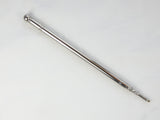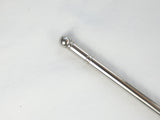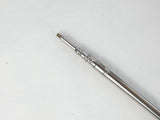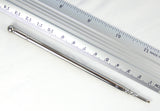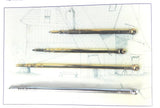Tablet pencils were designed to fit into notebooks or travelling writing cases, notebooks often incorporated loops to hold the pencil. The very slim profile endured that the notebook could open and close and remain flat.
This example bears a striking resemblance to the drawing in John holland's 1856 patent application. It does not have a makers name but is identical, even down to the two sets of grooves, to the pencils shown in the excellent 'Victorian Pencils' book by Deborah Crosby, and is probably from the mid 19th Century.
The pencils shown are made from brass but this version appears to be silver. There is no hallmark so it may be plated but there is no brassing and it has the distinctive look and feel of silver. Electroplating was in it's infancy at the time the pencil was made, with only one or two commercial plating plants.
This model was made in three sizes, 3, 3.5 and 5 inches in length, this is the longest version. It is in first class condition without any sign of a dint or surface abrasion and carries no personalisation.
The pencil is in excellent working order, the length of lead being controlled by turning the nozzle. I don't have any leads of the right diameter at the moment but I'm sure there are some out there. Any form of standardisation of lead sizes did not come about until much later.
A true antique, a tablet pencil is extremely hard to find, particularly in near mint condition.






